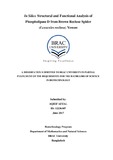| dc.contributor.advisor | Hossain, M. Mahboob | |
| dc.contributor.author | Afzal, Aqief | |
| dc.date.accessioned | 2018-01-21T05:02:20Z | |
| dc.date.available | 2018-01-21T05:02:20Z | |
| dc.date.copyright | 2017 | |
| dc.date.issued | 2017-06 | |
| dc.identifier.other | ID 12236007 | |
| dc.identifier.uri | http://hdl.handle.net/10361/9109 | |
| dc.description | This thesis report is submitted in partial fulfillment of the requirement for the degree of Bachelor of Science in Biotechnology, 2017. | en_US |
| dc.description | Cataloged from PDF version of thesis report. | |
| dc.description | Includes bibliographical references (page 57-59). | |
| dc.description.abstract | Spiders are an interesting class of insects - omnipresent in almost in all environment and vet, mostly remains unnoticed. They are carnivores in nature, relying on their own venom to neutralize their prey. There are many poisonous spider species but little is heard about spider bites in Bangladesh. The Brown Recluse, Loxosceles reclusa is one of the many spider species found in Bangladesh. It has deadly necrotic venom several components of which are medically significant. This project aims to study the venom composition of Brown Recluse and analyze the structure and function of a specific venom component. This In Silico project will help in narrowing wet lab research to particular venom proteins with medically useful attributes and thus reduce waste of wet lab resources and make future projects cost effective. Various online bioinformatics resources were utilized to predict the composition, structure and functional characteristics of the spider venom components. In the initial phase, a thorough literature review was carried out to elucidate the venom composition of the Brown Recluse spider. Then the desired target protein, Phospholipase D, was selected based on its potential therapeutic application. The protein was subjected to sequence based homology search to find out with other proteins sequences with best matches to it. These protein sequences were analyzed using global alignment to look for stretches of conserved regions within them. Predicted signal peptide is 20 a.a.long with cleavage between Asn18 and His19. In the later part, a phylogenetic tree was constructed based on their sequences to see their evolutionary divergence in respect to each other. It predicted that the target protein sequence was evolutionarily quite divergent and was placed in a separate sub group from the other proteins despite being similar to them in sequence. The target protein sequence was also analyzed using protein motif finding software to look for functional motifs. The protein motif finding software’s were able to find some motif or binding sites. Namely, three binding sites were seen, GDPD, PLC and Signal peptides. Lastly, the target protein’s 3D structure was constructed based on template structures of other proteins with similar sequences. The result predicted that the protein is almost globular in shape with a core formed by beta sheets on the inside and alpha helices forming the outer covering. This study shows that the structure of the target proteins quite unique- having a highly conserved sequence and yet being evolutionarily distant from other similar proteins from related spider species. | en_US |
| dc.description.statementofresponsibility | Aqief Afzal | |
| dc.format.extent | 62 pages | |
| dc.language.iso | en | en_US |
| dc.publisher | BRAC University | en_US |
| dc.rights | BRAC University thesis are protected by copyright. They may be viewed from this source for any purpose, but reproduction or distribution in any format is prohibited without written permission. | |
| dc.subject | Spider | en_US |
| dc.subject | Venom | en_US |
| dc.subject | Prey | en_US |
| dc.subject | Loxosceles reclusa | en_US |
| dc.subject | Brown recluse | en_US |
| dc.subject | In Silico | en_US |
| dc.title | In silico structural and functional analysis of phospholipase D from brown recluse spider (Loxoceles reclusa) venom | en_US |
| dc.type | Thesis | en_US |
| dc.contributor.department | Department of Mathematics and Natural Sciences, BRAC University | |
| dc.description.degree | B. Biotechnology | |

